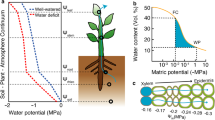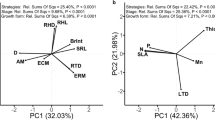Summary
The seasonal and diurnal water relations were investigated within arctic and alpine populations of the dwarf willow Salix arctica. Marked differences that were habitat dependent (e.g. xeric vs. mesic) occured both within and between the populations. The environmental variables that most affected plant water balance and the bulk tissue water relations were soil water potential (Ψsoil) and the leafto-air water vapor pressure gradient (Δw), however, low soil temperature (<4.0° C) also had a marked effect in the wet to mesic habitats. The effects of declining Ψsoil and increased ‡w were most pronounced in the plants growing in xiric habitats in both populations. Stomatal response to increased ‡w was two-fold greater in alpine versus arctic plants and is hypothesized to have arisen in response to more frequent exposure to the higher evaporative conditions of alpine existance. Seasonal fluctuations in the osmotic potential closely followed changes in Ψsoil, suggesting that these were active rather that passive changes. Additionally, plants from xeric habiats had a lower bulk tissue elastic modulus (more elastic tissues) in both arctic and alpine populations. The osmotic and elastic properties enhanced turgor maintenance over a broad range of leaf water potentials and during periods when ‡w was high. Turgor maintenance also correlated to continued transpiration despite fluctuations in soil and atmospherically induced water deficits. Arctic habitats have a shorter growing season, lower soil temperatures due to the presence of permafrost, but higher soil water potentials and lower leaf-to-air vapor pressure gradients than alpine habitats. The observed variation in patterns of stomatal conductance and in values of tissue water relations characteristics between arctic and alpine populations of S. arctica is hypothesized to have arisen in response to these different environmental regimes which represent different selective regimes that occur along the arctic-alpine environmental continuum inhabited by this wide ranging species.
Similar content being viewed by others
References
Ball CR (1950) A review of Salix anglorum and Salix petrophila. Am Midl Nat 43:224–241
Billings WD, Mooney HA (1968) The ecology of arctic and alpine plants. Biol Rev 43:1619–1626
Bliss LC (1956) A comparison of plant development in microenvironments of arctic and alpine tundras. Ecol Monogr 36:125–155
Bliss LC (1962) Adaptations of arctic and alpine plants to environmental conditions. Arctic 15:117–144
Bliss LC (1971) Arctic and alpine plant life cycles. Ann Rev Ecol Syst 2:405–438
Bliss LC (1977) (ed) Truelove Lowland, Devon Island, Canada: A High Arctic Ecosystem. University of Alberta Press. Edmonton
Bliss LC (1985) Alpine. In: Chabot BF, Mooney HA (eds) Physiological Ecology of North American Plant Communities, Chapman and Hall, New York. pp 41–65
Bowman WD (1988) Ionic and water relations responses of two populations of a non-halophyte to salinity. J Exp Bot 39:97–105
Bowman WD, Roberts SW (1985) Seasonal changes in tissue clasticity in chaparral shrubs. Physiol Plant 65:233–236
Boyer JS (1974) Water transport in plants: Mechanism of apparent changes in resistance during absorption. Planta 117:187–207
Chapin FS III, Shaver GR (1985) Arctic. In: Chabot BF, Mooney HA (eds) Physiological Ecology of North American Plant Communities, Chapman and Hall, New York. pp 16–40
Davis SD, Mooney HA (1986a) Water use patterns of four cooccuring chaparral shrubs. Oecologia 70:172–177
Davis SD, Mooney HA (1986b) Tissue water relations of four co-occuring chaparral shrubs. Oecologia 70:527–535
Dawson TE (1978) Comparative ecophysiological adaptations in arctic and alpine populations of a dioecious shrub, Salix arctica. Dissertation, University of Washington, Seattle
Dawson TE, Bliss LC (1989) Patterns of water use and tissue water relations in the dioecious shrub, Salix arctica: the physiological basis for habitat partitioning between the sexes. Oecologia 79:332–343
Ehleringer JR, Miller PC (1975) Water relations of selected plant species in the alpine tundra, Colorado. Ecology 56:370–380
Flower DJ, Ludlow MM (1986) Contribution of osmotic adjustment to dehydration tolerance of water-stressed pigeonpea (Cajanus cajan [L.] Millsp.) leaves. Plant, Cell, Environ 9:33–40
Grulke NE, Bliss LC (1988) Comparative life history characteristics of two high arctic grasses, Northwest Territories. Ecology 69:484–496
Hall AE, Schulze E-D, Lange OL (1976) Current perspectives of steady-state stomatal responses to environment. In: Lange OL, Kappen L, Schulze E-D (eds) Water and Plant Life, Springer-Verlag, Berlin Heidelberg New York
Hinckley TM, Ritchie GA (1972) Reaction of mature Abies seedlings to environmental stresses. Trans Mo Acad Sci 6:24–37
Hinckley TM, Duhme F, Hinckley AR, Richter H (1983) Drought relations of shrub species: assessment of the mechanisms of drought resistance. Oecologia 59:344–350
Hsiao TC, Acevedo E, Ferreres E, Henderson DW (1976) Water stress, growth, and osmotic adjustment. Phil Trans Royal Soc London B 273:479–500
Johnson DA, Caldwell MM (1975) Gas exchange of four arctic and alpine tundra plant species in relation to atmospheric and soil moisture stress. Oecologia 21:93–108
Johnson DA, Caldwell MM (1976) Water potential components, stomatal function, and liquid phase water transport resistances of four arctic and alpine species in relation to moisture stress. Physiol Plant 36:271–278
Kaufmann MR (1975) Leaf water stress in Engelmann spruce. Influence of root and shoot environments. Plant Physiol 56:841–844
Kikuta SB, Richter H (1986) Graphical evaluation and partitioning of turgor responses to drought in leaves of durum wheat. Planta 168:36–42
Körner Ch, Cochrane PM (1985) Stomatal responses and water relations of Eucalyptus pauciflora in summer along an elevational gradient. Oecologia 66:443–455
Ladiges PY (1975) Some aspects of tissue water relations in three populations of Eucalyptus viminalis Labill. New Phytol 75:53–62
Lange OL, Losch R, Schulze E-D, Kappen L (1971) Responses of stomata to changes in humidity. Planta 100:76–86
McCown BH (1975) Physiological responses of root systems to stress conditions. In: Vernberg FJ (ed) Physiological Adaptation to the Environment, Intext Educational Publishers, New York. pp 225–237
McGraw JB, Antonovics J (1983a) Experimental ecology of Dryas octopetala ecotypes. I. Ecotypic differentiation and life-cycle stages of selection. J Ecol 71:879–898
McGraw JB, Antonovics J (1983b) Experimental ecology of Dryas octopetala ecotypes. II. A demographic model of growth, branching, and fecundity. J Ecol 71:899–912
Meinzer FC, Rundel PW, Sharifi MR, Nilsen ET (1986) Turgor and osmotic relations of the desert shrub Larrea tridentata. Plant, Cell, Environ 9:467–475
Melkonian JJ, Wolfe J, Steponkus PL (1982) Determination of volumetric modulus of elasticity of wheat leaves by pressure-volume relations and the effects of drought conditioning. Crop Sci 22:116–123
Monson RK, Smith JD (1982) Seasonal water potential components of Sonoran desert plants. Ecology 63:113–123
Mooney HA, Billings WD (1961) Comparative physiological ecology of arctic and alpine populations of Oxyria digyma. Ecol Monogr 31:1–29
Mooney HA, Hiller RD, Billings WD (1965) Transpiration rates of alpine plants in the Sierra Nevada of California. Am Midl Nat 74:374–386
Morgan JM (1984) Osmoregulation and water stress in higher plants. Ann Rey Plant Physiol 35:299–319
Muc M (1977) Ecology and primary production of sedge-moss meadow communities, Truelove Lowland. In: Bliss LC (ed) Truelove Lowland, Devon Island, Canada: A High Arctic Ecosystem, University of Alberta Press, Edmonton. pp 157–184
Oberbauer SF, Billings WD (1981) Drought tolerance and water use by plants along an alpine topographic gradient. Oecologia 50:325–331
Oberbauer SF, Miller PC (1979) Plant water relations in montane and tussock tundra vegetation types in Alaska. Arct Alp Res 11:69–81
Osonubi O, Davies WJ (1981) Root growth and water relations of oak and birch seedlings. Oecologia 51:343–350
Parker WC, Pallardy SG (1987) The influence of rehydration method and tissue type on pressure-volume analysis of Quercus alba L. seedlings. J Exp Bot 38:535–549
Pavlick BM (1984) Seasonal changes in osmotic pressure, symplastic water content, and tissue elasticity in the blades of dune grasses growing in situ along the coast of Oregon. Plant, Cell, Environ 7:537–539
Peterson KM, Billings WD (1982) Growth of alpine plants under controlled drought. Arct Alp Res 14:189–194
Porsild AE, Cody WJ (1980) Vascular Plants of Continential Northwest Territories, Canada. National Museum of Canada Publication, Ottawa
Richards LA (1949) Methods of measuring soil moisture tension. Soil Sci 68:95–112
Richter H, Duhme F, Glatzel G, Hinckley TM, Karlic H (1978) Some limitations and applications of the pressure-volume curve technique in ecophysiological research. In: Grace J, Ford ED, Jarvis PG (eds) Plants and their Atmospheric Environment, Blackwell Scientic, London. pp 263–272
Roberts SW, Strain BR, Knoerr KR (1980) Seasonal patterns of leaf water relations in four co-occuring forest tree species: parameters from pressure-volume curves. Oecologia 46:330–337
Robichaux RH (1984) Variation in the tissue water relations of two sympatric Hawaiian Dubautia species and their natural hybrid. Oecologia 65:75–81
Robichaux RH, Canfield JE (1985) Tissue elastic properties of eight Hawaiian Dubautia species that differ in habitat and diploid chromosome number. Oecologia 66:77–80
Robichaux RH, Holsinger KE, Morse SR (1986) Turgor maintenance in Hawaiian Dubautia species: the role of variation in tissue osmotic and elastic properties. In: Givnish TJ (ed) On the Economy of Plant Form and Function, Cambridge University Press, Cambridge. pp 353–380
Running S, Reid CP (1980) Soil conductance influences on root resistance of Pinus contorta seedlings. Plant Physiol 65:635–640
Schulte PJ, Hinckley TM (1985) A comparison of pressure-volume curve data analysis techniques. J Exp Bot 15:1590–1602
Schulze E-D, Lange OL, Buschbom U, Kappen L, Everari M (1972) Stomatal responses to changes in humidity in plants growing in the desert. Planta 108:259–270
Shaver GR, Chapin FS III, Billings WD (1979) Ecotypic differentiation of Carex aquatilis on ice-wedge polygons in the Alaskan coastal tundra. J Ecol 67:1025–1046
Shaver GR, Chapin FS III, Gartner BL (1986) Factors limiting seasonal growth and peak biomass accumulation in Eriophorum vaginatum in an Alaskan tussock tundra. J Ecol 74:257–278
Svoboda J (1977) Ecology and primary production of raised beach ridge communities, Truelove Lowland. In: Bliss LC (ed) Truelove Lowland, Devon Island, Canada: A High Arctic Ecosystem. University of Alberta Press, Edmonton
Teskey RO, Hinckley TM, Grier CC (1984) Temperature-induced changes in the water relations of Abies amabilis (Dougl.) Forbes. Plant Physiol 74:77–80
Turner NC, Jones MM (1980) Turgor maintenance by osmotic adjustment: a review and evaluation. In: Turner NC, Kramer PJ (eds) Adaptation of Plants to Water and High Temperature Stress, John Wiley and Sons, New York. pp 87–103
Tyree MT, Jarvis P (1982) Water in tissues and cells. In: Lange OL, Nobel PS, Osmond CB, Ziegler H (eds) Encyclopedia of Plant Physiology, new series, vol 12 B, Springer, Berlin Heidelberg New York pp 35–77
Tyree MT, Richter H (1981) Alternative methods for analyzing water potential isotherms: some cautions and clarifications. I. The impact of non-ideality and some experimental errors. J Exp Bot 32:642–653
Tyree MT, Richter H (1982) Alternative methods for analyzing water potential isotherms: some cautions and clarifications. II. Curvilinearity in water potential isotherms. Can J Bot 60:912–916
Walker BD, Peters TW (1977) Soils of Truelove Lowland and plateau. In: Bliss LC (ed) Truelove Lowland, Devon Island, Canada: A High Arctic Ecosystem, University of Alberta Press, Edmonton. pp 31–62
Warren Wilson J (1964) Annual growth of Salix arctica in the High-Arctic. Ann Bot 28:71–76
Wijk S (1986a) Perrormance of Salix herbacea in an alpine snowbed gradient. J Ecol 74:675–684
Wijk S (1986b) Influence of climate on age and annual shoot increment in Salix herbacea. J Ecol 74:685–692
Wilson JR, Ludlow MM (1983) Time trends for change in osmotic adjustment and water relations of leaves of Cenchrus ciliaris during and after water stress. Aust J Plant Physiol 10:15–24
Wilson JR, Fisher MJ, Schulze E-D, Dolby GR, Ludlow MM (1979) Comparison between pressure-volume and dew-point-hygrometry techniques of determining the water relations characteristics of grass and legume leaves. Oecologia 41:77–88
Author information
Authors and Affiliations
Rights and permissions
About this article
Cite this article
Dawson, T.E., Bliss, L.C. Intraspecific variation in the water relations of Salix arctica, an arctic-alpine dwarf willow. Oecologia 79, 322–331 (1989). https://doi.org/10.1007/BF00384311
Received:
Published:
Issue Date:
DOI: https://doi.org/10.1007/BF00384311




